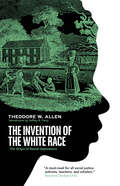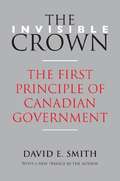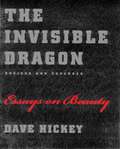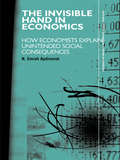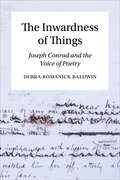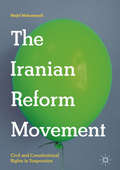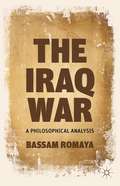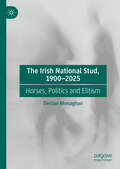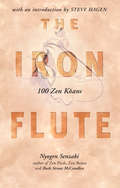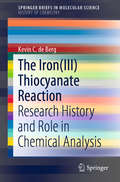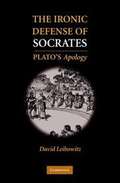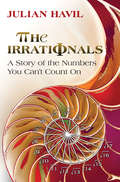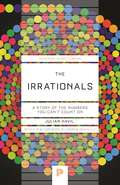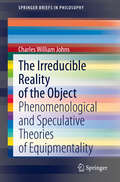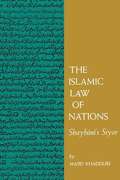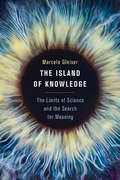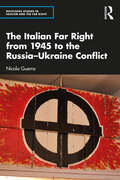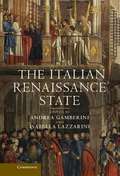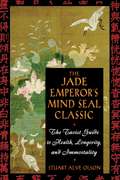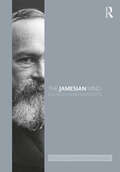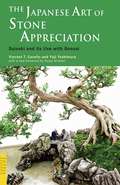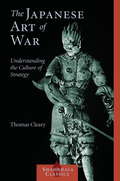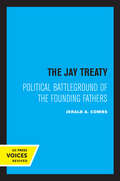- Table View
- List View
The Invention of the White Race: The Origin of Racial Oppression (The\invention Of The White Race Ser. #1)
by Theodore W. AllenWhen the first Africans arrived in Virginia in 1619, there were no &“white&” people there; nor, according to colonial records, would there be for another sixty years. Historical debate about the origin of racial slavery has focused on the status of the Negro in seventeenth-century Virginia and Maryland. However, as Theodore W. Allen argues in this magisterial work, what needs to be studied is the transformation of English, Scottish, Irish and other European colonists from their various statuses as servants, tenants, planters or merchants into a single new all-inclusive status: that of whites. This is the key to the paradox of American history, of a democracy resting on race assumptions.Volume One of this two-volume work attempts to escape the &“white blind spot&” which has distorted consecutive studies of the issue. It does so by looking in the mirror of Irish history for a definition of racial oppression and for an explanation of that phenomenon in terms of social control, free from the absurdities of classification by skin color. Compelling analogies are presented between the history of Anglo-Irish and British rule in Ireland and American White Supremacist oppression of Indians and African-Americans. But the relativity of race is shown in the sea change it entailed, whereby emigrating Irish haters of racial oppression were transformed into White Americans who defended it. The reasons for the differing outcomes of Catholic Emancipation and Negro Emancipation are considered and occasion is made to demonstrate Allen&’s distinction between racial and national oppression.
The Invisible Crown
by David E. SmithThe Crown is not only Canada's oldest continuing political institution, but also its most pervasive, affecting the operation of Parliament and the legislatures, the executive, the bureaucracy, the courts, and federalism. However, many consider the Crown to be obscure and anachronistic. David E. Smith's The Invisible Crown was one of the first books to study the role of the Crown in Canada, and remains a significant resource for the unique perspective it offers on the Crown's place in politics.The Invisible Crown traces Canada's distinctive form of federalism, with highly autonomous provinces, to the Crown's influence. Smith concludes that the Crown has greatly affected the development of Canadian politics due to the country's societal, geographic, and economic conditions. Praised by the Globe and Mail's Michael Valpy as "a thoroughly lucid, scholarly explanation of how the Canadian constitutional monarchy works," it is bolstered by a new foreword by the author speaking to recent events involving the Crown and Canadian politics, notably the prorogation of Parliament in 2008.
The Invisible Dragon: Essays on Beauty
by Dave HickeyThe Invisible Dragon made a lot of noise for a little book When it was originally published in 1993 it was championed by artists for its forceful call for a reconsideration of beauty--and savaged by more theoretically oriented critics who dismissed the very concept of beauty as naive, igniting a debate that has shown no sign of flagging. With this revised and expanded edition, Hickey is back to fan the flames. More manifesto than polite discussion, more call to action than criticism, The Invisible Dragon aims squarely at the hyper-institutionalism that, in Hickey's view, denies the real pleasures that draw us to art in the first place. Deploying the artworks of Warhol, Raphael, Caravaggio, and Mapplethorpe and the writings of Ruskin, Shakespeare, Deleuze, and Foucault, Hickey takes on museum culture, arid academicism, sclerotic politics, and more--all in the service of making readers rethink the nature of art. A new introduction provides a context for earlier essays--what Hickey calls his "intellectual temper tantrums. " A new essay, "American Beauty," concludes the volume with a historical argument that is a rousing paean to the inherently democratic nature of attention to beauty. Written with a verve that is all too rare in serious criticism, this expanded and refurbished edition of The Invisible Dragon will be sure to captivate a new generation of readers, provoking the passionate reactions that are the hallmark of great criticism.
The Invisible Hand in Economics: How Economists Explain Unintended Social Consequences (Routledge Inem Advances In Economic Methodology Ser.)
by N. Emrah AydinonatThis is a book about one of the most controversial concepts in economics: the invisible hand. The author explores the unintended social consequences implied by the invisible hand and discusses the mechanisms that bring about these consequences.The book questions, examines and explicates the strengths and weaknesses of invisible-hand explanations co
The Invisible Master: Secret Chiefs, Unknown Superiors, and the Puppet Masters Who Pull the Strings of Occult Power from the Alien World
by Brad Olsen Leo Lyon ZagamiLeo Zagami’s groundbreaking information on the UFO/alien phenomenon, that can be defined as having historical significance, shows us with extreme clarity where we come from, and who guides us for millennia in our political and religious choices, through prophets, initiates and magicians, that during all the ages have drawn from a common source of ultra-terrestrial and magical knowledge, known only by the initiates of the old mystery schools. Now we will finally understand who the Unknown Superiors really are, the Secret Chiefs or Invisible Masters, that have guided Freemasonry, the Illuminati and the various power groups associated with them. For the first time you will have access to their secrets, to understand this alien reality, and its true implications for humanity, that in the months and years to come, will be increasingly evident. The author speaks to us of the existence of multidimensional doors, gates to the infinite, used by the various Illuminati to let such entities into our world, and does so using the latest discoveries of quantum physics to support his shocking revelations. Thus analyzing inaccessible secrets to most, Zagami invites us once again to rediscuss our reality with puzzling truths about the mystery tradition and its schools linked to beings with supernatural powers since antiquity, and now to places like CERN. This shocking text is released at a very precise historical moment, to enlighten all to an imminent turning point for mankind. This is an enlightening handbook to read again and again in the years to come, as a guide on this topic, as well as a book that we dare to define as the best from the author.
The Inwardness of Things: Joseph Conrad and the Voice of Poetry
by Debra Romanick BaldwinThe Inwardness of Things considers Joseph Conrad as a modern voice in an ancient and enduring quarrel between the poets and the philosophers. Beginning from the polemical poetics of his 1897 preface, Debra Romanick Baldwin focuses on Conrad’s distinctively poetic “inward” approach to truth – an inwardness that is found in lived experience, in language, and in the world beyond the individual. The book traces Conrad’s poetic voice from the rhetoric of his private letters to the narrative techniques of his fiction and finally to his explicit engagement with abstract approaches to truth. Baldwin applies narrative and rhetorical analysis to Conrad’s private correspondence, showing how he encouraged fellow writers – John Galsworthy, F. Warrington Dawson, R.B. Cunninghame Graham, Ted Sanderson, and Edward Noble – to engage with the inwardness of their own experience. The book explores how Conrad crafted moments of narrative solidarity in his fictional narratives to evoke the experience of the inwardness of another, while also considering his explicit polemics against abstract approaches to truth-seeking. Mindful of the colonial, late Victorian, Polish Romantic, and cosmopolitan contexts in which Conrad wrote, The Inwardness of Things nevertheless situates him in a broader human conversation that he himself invited and argues for the enduring value of his art.
The Iranian Reform Movement: Civil and Constitutional Rights in Suspension
by Majid MohammadiThis book analyzes the reform movement in Iran and traces its political roots from the beginning of the 20th century to its relative demise with the purging of the Green Movement after the 2009 disputed elections. The author explains how this movement was shaped in a country with an authoritarian Islamist regime, how it grew, and what its achievements are, including its failures and setbacks. The project will appeal to scholars and students in the fields of Middle Eastern politics and sociology, Iranian politics, democracy, and the US-Iran relations.
The Iraq War
by Bassam RomayaThis book features a critique of key philosophical doctrines that dominate the Iraq war debate: just war theory, humanitarian intervention, democratic realism, and preventive war doctrine. The author evaluates each and develops a philosophical approach that offers a model for thinking through the philosophical dilemmas introduced by new wars.
The Irish National Stud, 1900-2025: Horses, Politics and Elitism
by Declan MonaghanThis book examines the history of a pioneering Thoroughbred horse breeding operation, the Irish National Stud. By incorporating and integrating a diverse array of primary sources from various repositories and supplementing them with contemporary and secondary materials, the main narrative reveals the intricate details of Ireland&’s complex relationship with Britain through sport and politics. The publication adopts a chronological, thematic approach, beginning at the turn of the nineteenth century and tracing the development of the Stud through the twentieth century and into the twenty-first century. This book encompasses the political, cultural, and social dimensions of horse breeding/racing and the role of what would become the Irish National Stud. The first period of its history covers the establishment of Tully Stud in Kildare under Colonel William Hall-Walker in 1900. The second period, from 1916 to 1944, begins with Hall-Walker &‘gifting&’ Tully Stud to the British government, which then rebranded it as the &‘National Stud&’. This coincided with the Irish independence struggle and the formation of the new Irish Free State, leading to over two decades of deadlock over which government—Irish or British—legally owned the Stud. The third period saw the progression of the new Irish National Stud, from its creation in 1944 to the present day, offering a comparison with the British National Stud and providing a thorough analysis of the influence of elite Thoroughbred breeders on the Irish National Stud and the broader industry in both Ireland and Great Britain.
The Iron Flute
by Nyogen Senzaki Ruth Strout MccandlessKoans are the intellectually unsolvable problem-riddles at the core of the Rinzai tradition of Zen Buddhism, perhaps the most well-known one being "what is the sound of one hand clapping." Though widely recognized, most koan remain narrowly understood. In this new edition of The Iron Flute, one hundred of the most challenging and enlightening koan from the Chinese Chan (Zen) patriarchs of the Tang and Sung dynasties are presented, along with commentary from the great Zen masters Genro, Fugai, and Nyogen, and an in-depth biography of author Nyogen Senzaki (1876-1958), a pioneer in bringing Zen Buddhism to the West. The Iron Flute stands alone as the definitive work on koan-an essential pathway to the tenets and practice of Zen Buddhism. AUTHOR BIOS: Nyogen Senzaki was raised in Tendai Buddhist monastery and ordained as a Zen monk after attending Tokyo Imperial University, where he was a student of the great Zen master Soen Shoku. He moved to the U.S. in 1905 and lived in Los Angeles until his death in 1958. Ruth Strout McCandless was a student of Senzaki and his collaborator in translating a series of Buddhist texts over many years. She and Senzaki also co-authored Buddhism and Zen.
The Iron: Research History and Role in Chemical Analysis (SpringerBriefs in Molecular Science)
by Kevin C. de BergThis Brief presents an historical investigation into the reaction between ferric ions and thiocyanate ions, which has been viewed in different ways throughout the last two centuries. Historically, the reaction was used in chemical analysis and to highlight the nature of chemical reactions, the laws of chemistry, models and theories of chemistry, chemical nomenclature, mathematics and data analysis, and instrumentation, which are important ingredients of what one might call the nature of chemistry. Using the history of the iron(III) thiocyanate reaction as a basis, the book’s main objective is to explore how chemistry develops its own knowledge base; how it assesses the reliability of that base; and how some important tools of the trade have been brought to bear on a chemical reaction to achieve understanding, a worthwhile goal of any historical investigation.
The Ironic Defense of Socrates
by David LeibowitzThis book offers a controversial new interpretation of Plato's Apology of Socrates. By paying unusually close attention to what Socrates indicates about the meaning and extent of his irony, David Leibowitz arrives at unconventional conclusions about Socrates' teaching on virtue, politics, and the gods; the significance of his famous turn from natural philosophy to political philosophy; and the purpose of his insolent "defense speech. " Leibowitz shows that Socrates is not just a colorful and quirky figure from the distant past but an unrivaled guide to the good life - the thoughtful life - who is as relevant today as in ancient Athens. On the basis of his unconventional understanding of the dialogue as a whole, and of the Delphic oracle story in particular, Leibowitz also attempts to show that the Apology is the key to the Platonic corpus, indicating how many of the disparate themes and apparently contradictory conclusions of the other dialogues fit together.
The Irrationals: A Story of the Numbers You Can't Count On
by Julian HavilThe ancient Greeks discovered them, but it wasn't until the nineteenth century that irrational numbers were properly understood and rigorously defined, and even today not all their mysteries have been revealed. InThe Irrationals, the first popular and comprehensive book on the subject, Julian Havil tells the story of irrational numbers and the mathematicians who have tackled their challenges, from antiquity to the twenty-first century. Along the way, he explains why irrational numbers are surprisingly difficult to define--and why so many questions still surround them. That definition seems so simple: they are numbers that cannot be expressed as a ratio of two integers, or that have decimal expansions that are neither infinite nor recurring. But, asThe Irrationalsshows, these are the real "complex" numbers, and they have an equally complex and intriguing history, from Euclid's famous proof that the square root of 2 is irrational to Roger Apry's proof of the irrationality of a number called Zeta(3), one of the greatest results of the twentieth century. In between, Havil explains other important results, such as the irrationality of e and pi. He also discusses the distinction between "ordinary" irrationals and transcendentals, as well as the appealing question of whether the decimal expansion of irrationals is "random". Fascinating and illuminating, this is a book for everyone who loves math and the history behind it.
The Irrationals: A Story of the Numbers You Can't Count On (Princeton Science Library #135)
by Julian HavilAn entertaining and enlightening history of irrational numbers, from ancient Greece to the twenty-first centuryThe ancient Greeks discovered them, but it wasn't until the nineteenth century that irrational numbers were properly understood and rigorously defined, and even today not all their mysteries have been revealed. In The Irrationals, the first popular and comprehensive book on the subject, Julian Havil tells the story of irrational numbers and the mathematicians who have tackled their challenges, from antiquity to the twenty-first century. Along the way, he explains why irrational numbers are surprisingly difficult to define—and why so many questions still surround them. Fascinating and illuminating, this is a book for everyone who loves math and the history behind it.
The Irreducible Reality of the Object: Phenomenological and Speculative Theories of Equipmentality (SpringerBriefs in Philosophy)
by Charles William JohnsThis intriguing and compact book investigates whether or not philosophy can have a use in the face of ‘capitalist realism’ today. Can philosophy study everyday objects like computers and mobile phones? Can it think of advertising, the population, electricity, buildings and even dreams as ‘objects’ in their own right, which convey particular and novel qualities when analysed?Johns’ book starts from an immanent phenomenological study of objects, arguing that such objects disclose larger systems of anthropological meaning and control. The author moves away from the Husserlian ‘essence’ of the object and embeds his objects in a series of ‘uses’ (or ‘equipment’ as Heidegger called it). However, Johns makes a speculative move by positing the very existence of such ‘uses’ distinct from the human and first person phenomenological consciousness. This is when the annals of phenomenology meet contemporary strands of realism such as Speculative and Object Oriented models. For Johns, the world is in a constant state of being utilised, not merely through humans but through objects and their relations, and not only on a macro scale but on a micro scale (described by the theories of quantum physics).The object then becomes a locus of use, yet, importantly, one that can never be reduced to relations alone. This is because the author believes that certain aspects of a relation withholds itself in its act of relating. The mutual dynamics of relation and property are thus rearticulated in a new light. This novel description of relation places Johns squarely between relational ontologies (such as Deleuze, Latour and Garcia) and non-relational ontologies (Harman).This work is invaluable to researchers and any reader of contemporary philosophy in the age of advanced technology and capitalism.
The Islamic Law of Nations: Shaybani's Siyar
by Majid Khadduri Muhammad ibn al-Hasan al-ShaybaniTranslated with an extensive commentary by Majid Khadduri, Shaybani's Siyar describes in detail conditions for war (jihad) and for peace, principles for the conduct of military action and of diplomacy, and rules for the treatment of non-Muslims in Muslim lands. A foundational text of the leading school of law in Sunni Islam, it provides essential insights into relations between Islamic nations and the larger world from their earliest days up to the present.
The Island of Knowledge: The Limits of Science and the Search for Meaning
by Marcelo GleiserWhy discovering the limits to science may be the most powerful discovery of all How much can we know about the world? In this book, physicist Marcelo Gleiser traces our search for answers to the most fundamental questions of existence, the origin of the universe, the nature of reality, and the limits of knowledge. In so doing, he reaches a provocative conclusion: science, like religion, is fundamentally limited as a tool for understanding the world. As science and its philosophical interpretations advance, we face the unsettling recognition of how much we don’t know. Gleiser shows that by abandoning the dualistic model that divides reality into the known and the unknown, we can embark on a third way based on the acceptance of our limitations. Only then, he argues, will we be truly able to experience freedom; for to be free in an age of science we cannot turn science into a god. Gleiser ultimately offers an uplifting exploration of humanity’s longing to conquer the unknown, and of science’s power to transform and inspire.
The Italian Far Right from 1945 to the Russia-Ukraine Conflict (Routledge Studies in Fascism and the Far Right)
by Nicola GuerraThe Italian Far Right from 1945 to the Russia–Ukraine Conflict provides a comprehensive account of the postwar parliamentary and extra parliamentary far right in Italy. This book explores the ideology, movements and activism of the extreme right and neo- fascists. The recent victory in the Italian parliamentary elections of the ‘postfascist’ party Fratelli d’Italia and its leader Giorgia Meloni highlights the importance of such research. The book examines why some of these movements participated with CIA- backing in the ‘Strategy of Tension’ in the years of the Cold War where terrorist actions aimed to keep Italy in NATO and prevent the Communist Party from coming to power, while other extreme- right groups vehemently opposed this and what they considered the dangerous ‘Americanization’ of the country. It debunks the myth that there was a unified postwar fascist movement in Italy, but instead excavates the complex battles within the extreme right as well as with their opponents from the left, and the authorities. This study is necessary to clarify the history and ideological dynamics of a political area still too often shrouded in mystery and whose geopolitical role is still poorly understood and generally underestimated. The analysis is contextualized in the present day by looking at the different perspectives of the Italian far right on the Russian invasion of Ukraine. The book will be of interest to researchers of political history, the Cold War and Italian history and politics.
The Italian Far Right from 1945 to the Russia-Ukraine Conflict (Routledge Studies in Fascism and the Far Right)
by Nicola GuerraThe Italian Far Right from 1945 to the Russia–Ukraine Conflict provides a comprehensive account of the postwar parliamentary and extra parliamentary far right in Italy. This book explores the ideology, movements and activism of the extreme right and neo- fascists. The recent victory in the Italian parliamentary elections of the ‘post-fascist’ party Fratelli d’Italia and its leader Giorgia Meloni highlights the importance of such research. The book examines why some of these movements participated with CIA- backing in the ‘Strategy of Tension’ in the years of the Cold War where terrorist actions aimed to keep Italy in NATO and prevent the Communist Party from coming to power, while other extreme- right groups vehemently opposed this and what they considered the dangerous ‘Americanization’ of the country. It debunks the myth that there was a unified postwar fascist movement in Italy, but instead excavates the complex battles within the extreme right as well as with their opponents from the left, and the authorities. This study is necessary to clarify the history and ideological dynamics of a political area still too often shrouded in mystery and whose geopolitical role is still poorly understood and generally underestimated. The analysis is contextualized in the present day by looking at the different perspectives of the Italian far right on the Russian invasion of Ukraine. The book will be of interest to researchers of political history, the Cold War and Italian history and politics.
The Italian Renaissance State
by Andrea Gamberini Isabella Lazzarini"This magisterial study proposes a revised and innovative view of the political history of Renaissance Italy. Drawing on comparative examples from across the peninsula and the kingdoms of Sicily, Sardinia and Corsica, an international team of leading scholars highlights the complexity and variety of the Italian world from the fourteenth to early sixteenth centuries, surveying the mosaic of kingdoms, principalities, signorie and republics against a backdrop of wider political themes common to all types of state in the period. The authors address the contentious problem of the apparent weakness of the Italian Renaissance political system. By repositioning the Renaissance as a political, rather than simply an artistic and cultural phenomenon, they identify the period as a pivotal moment in the history of the state, in which political languages, practices and tools, together with political and governmental institutions, became vital to the evolution of a modern European political identity"--
The Jade Emperor's Mind Seal Classic: The Taoist Guide to Health, Longevity, and Immortality
by Stuart Alve OlsonThe first English translation with commentary of three classic Taoist texts on immortality• Translates The Jade Emperor’s Mind Seal Classic, The Immortals, and The Three Treasures of Immortality• Defines the Taoist concept of immortality and examines the lives and practices of Taoists who achieved this state• Reveals the steps needed to achieve immortality in our modern societyTaoist mystics claim that it is possible to achieve immortality: “Within each of us dwells the medicine to cure the affliction of mortality.” Now Western readers can access the wisdom of Taoist masters on the subject of immortality through the first English translations of three classic Taoist treatises: The Jade Emperor’s Mind Seal Classic; The Immortals, from the Pao P’u Tzu by Ko Hung of the Sung Dynasty; and The Three Treasures of Immortality, from the Dragon Gate Sect. The Jade Emperor’s Mind Seal Classic teaches that one can attain immortality through the cultivation of the three treasures of Taoism: ching (sexual and physical energy), qi (breath and vital energy), and shen (spirit and mental energy). Chinese history is sprinkled with accounts of individuals who applied the lessons of the Jade Emperor and lived up to 200 years. Drawing on his extensive knowledge of Taoism, martial arts, and Chinese history and culture, Stuart Alve Olson accompanies his translations with informative commentary that explains the historical context of the texts as well as demonstrates the practical applications of their teachings in contemporary life.
The Jamesian Mind (Routledge Philosophical Minds)
by Sarin MarchettiWilliam James (1842–1910) is widely regarded as the founding figure of modern psychology and one of the most important philosophers of the nineteenth and twentieth centuries. Renowned for his philosophical theory of pragmatism and memorable turns of phrase, such as ‘stream of consciousness’ and the ‘will to believe’, he made enormous contributions to a rich array of philosophical subjects, from the emotions and free will to religion, ethics, and the meaning of life. The Jamesian Mind covers the major aspects of James’s thought, from his early influences to his legacy, with over forty chapters by an outstanding roster of international contributors. It is organized into seven parts: Intellectual Biography Psychology, Mind, and Self Ethics, Religion, and Politics Method, Truth, and Knowledge Philosophical Encounters Legacy. In these sections fundamental topics are examined, including James’s conceptions of philosophical and scientific inquiry, habit, self, free will and determinism, pragmatism, truth, and pluralism. Considerable attention is also devoted to James in relation to the intellectual traditions of empiricism and Romanticism as well as to such other philosophical schools as utilitarianism, British idealism, Logical Empiricism, and existentialism. James’s thought is also situated in an interdisciplinary context, including modernism, sociology, and politics, showcasing his legacy in psychology and ethics. An indispensable resource for anyone studying and researching James’s philosophy, The Jamesian Mind will also interest those in related disciplines such as psychology, religion, and sociology.
The Japanese Art of Stone Appreciation: Suiseki and its Use with Bonsai (Tuttle Classics)
by Yuji Yoshimura Sonja Arntzen Vincent T. CovelloThe Japanese Art of Stone Appreciation is an exploration into the art of suiseki--small, naturally formed stones selected for their shape, balance, simplicity and tranquility.<P><P>Written by two leading experts in the field of Japanese gardening and art, this concise introduction offers aesthetic guidance and direct practical advice that is a window into traditional Japanese culture. It details the essential characteristics of a high-quality suiseki, describing the various systems of stone classification in this Japanese art form and explaining how to display a suiseki to its best advantage. There is also a section on incorporating suiseki alongside a bonsai tree, the most popular and rewarding complement to peaceful suiseki miniature landscape gardens.Sections include:Historical BackgroundCharacteristics and Aesthetic QualitiesClassification of SuisekiDisplaying a StoneSuiseki with Bonsai and Other Related ArtsCollecting SuisekiHow to Make a Carved Wooden BaseSuiseki Classification Systems
The Japanese Art of War: Understanding the Culture of Strategy
by Thomas ClearyMilitary rule and the martial tradition of the samurai dominated Japanese culture for more than eight hundred years. According to Thomas Cleary--translator of more than thirty-five classics of Asian philosophy--the Japanese people have been so steeped in the way of the warrior that some of the manners and mentality of this outlook remain embedded in their individual and collective consciousness. Cleary shows how well-known attributes such as the reserve and mystery of formal Japanese behavior are deeply rooted in the ancient strategies of the traditional arts of war. Citing original Japanese sources that are popular among Japanese readers today, he reveals the hidden forces behind Japanese attitudes and conduct in political, business, social, and personal life.
The Jay Treaty: Political Battleground of the Founding Fathers
by Jerald A. CombsThis title is part of UC Press's Voices Revived program, which commemorates University of California Press’s mission to seek out and cultivate the brightest minds and give them voice, reach, and impact. Drawing on a backlist dating to 1893, Voices Revived makes high-quality, peer-reviewed scholarship accessible once again using print-on-demand technology. This title was originally published in 1970.
